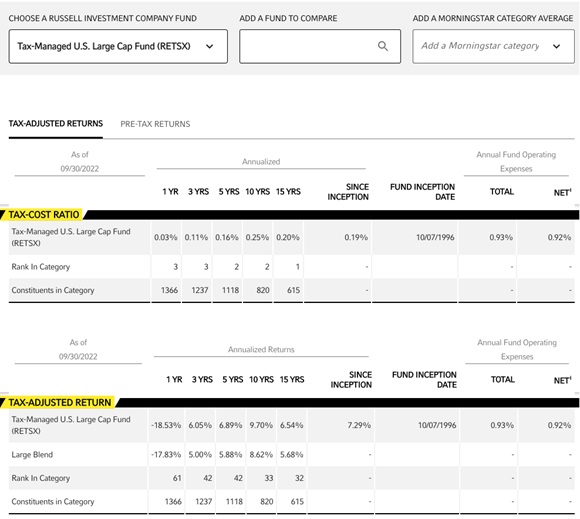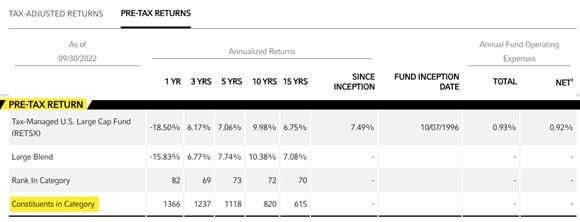We’ve spent the better part of the last 10+ years talking about the serious headwinds that taxes have on investor returns. It’s one thing to conceptually understand why taxes can reduce investment returns, but it’s a completely different thing to actually see how big this impact can be.
Seeing is believing
When evaluating investment options, investors typically look at pre-tax returns, net expense ratios, fund size, active share, portfolio turnover and similar statistics.
But taxable investors tend to overlook the figures that have as big or bigger impact: the amount of return surrendered to taxes and the actual after-tax returns. The return lost to taxes is often a higher number than the stated expense ratio. You could say that it serves as an additional fund expense for the benefit of Uncle Sam.
A tool for enhanced visibility
To help investors see this tax impact, we offer our Tax Impact Comparison Tool. It helps you show your clients the magnitude of this hidden expense ratio. We work with and educate many advisors on how to incorporate the magnitude of tax drag in their conversations with both clients and prospects. Making it easier to evaluate the benefits of tax-managed investing can help these discussions be more compelling.
Discovery and insights across investment products & categories
Our online tool is intended as a resource to help advisors and their clients make informed decisions about the tax-impact of different investments.
By way of example, looking broadly at U.S. equity products (active, passive, ETFs), the average product surrendered 2% of its pre-tax return to taxes for the three years ending September 2022 according to Morningstar* Since this is an average, some investment products lose a materially higher amount and some lose less.
The tool gives you the ability to compare thousands of mutual funds, ETFs and Morningstar categories so that you can better determine the tax implications between products and categories.
How to use the Tax Impact Comparison Tool in 3 easy steps
- Step 1: Start by accessing the tool here or from any of our tax-managed mutual fund pages
- Step 2: Select a Russell Investments Fund
- Step 3: Then add a mutual fund, ETF and/or Morningstar peer universe category to compare
Two presentation options are available
The tool enables you to easily select two different views so you can look at both return lost to taxes and tax-adjusted returns or pre-tax returns.
1. Tax-adjusted returns:
Click image to enlarge
Note: For illustrative purposes only. Performance information is historical and does not guarantee future results. Investment return and principal value of an investment will fluctuate so that an investor's shares, when redeemed, may be worth more or less than their original cost. Current performance may be lower or higher than the performance data quoted.
- Tax-Cost Ratio / return lost to taxes:
- This hard-to-find number from Morningstar shows how much return is lost to taxes or the “hidden” expense ratio. Like all expenses, lower is better.
- Note the % Rank in Category. How did the product compare to peers in reducing tax drag? Again, lower is better.
- Tax-Adjusted Return shows the pre-liquidation after-tax return for selected products. These returns are oftentimes difficult to find elsewhere. We’ve brought these front and center for your review and show returns after accounting for paying relevant federal taxes on any income (dividends, interest) and capital gain distributions during the period. The calculation follows the official SEC methodology.
- Also note the % Rank in Category. Many funds will move up (or down) in their universe when taxes are taken into consideration.
2. Pre-tax returns:
Click image to enlarge
Note: For illustrative purposes only. Performance information is historical and does not guarantee future results. Investment return and principal value of an investment will fluctuate so that an investor's shares, when redeemed, may be worth more or less than their original cost. Current performance may be lower or higher than the performance data quoted.
- Shows standardized pre-tax returns investors are accustomed to seeing.
- Note the % Rank in Category and compare it to the ranking in the Tax-Adjusted Return section.
- Did the fund move up or down vs. peers? A tax-managed offering should improve.
Pursuing value with tax-managed investing
In our annual Value of an Advisor study, helping clients reduce the impact of taxes is one of the greater value-adds advisors bring to the client relationship. Why? Because when it comes to investing, it’s not what investors make, it’s what they get to keep that matters most in the long run. That’s why we provide a tool that allows you to make better, more informed decisions as you demonstrate the value of tax-managed funds.
The bottom line
Bringing this tool to the marketplace in 2020 was another milestone in our drive to be an industry leader in tax-managed investing. We started this journey back in 1985 with the launch of our first tax-exempt bond fund, and we’ve been helping investors grow after-tax wealth ever since. In the late 90s we added tax-managed U.S. equity funds, introduced our tax-managed model strategies in 2003, and have followed that with product innovation in the international, real asset, and municipal high-yield bond space.
The goal of our Tax Impact Comparison Tool is to offer another way for advisors to bring even more value to their practice. The tool is designed to help advisors make informed decisions around the tax impact of investments so their clients can keep more of what they earn.
Disclosures
These views are subject to change at any time based upon market or other conditions and are current as of the date at the top of the page. The information, analysis, and opinions expressed herein are for general information only and are not intended to provide specific advice or recommendations for any individual or entity.
This material is not an offer, solicitation or recommendation to purchase any security.
Forecasting represents predictions of market prices and/or volume patterns utilizing varying analytical data. It is not representative of a projection of the stock market, or of any specific investment.
Nothing contained in this material is intended to constitute legal, tax, securities or investment advice, nor an opinion regarding the appropriateness of any investment. The general information contained in this publication should not be acted upon without obtaining specific legal, tax and investment advice from a licensed professional.
Please remember that all investments carry some level of risk, including the potential loss of principal invested. They do not typically grow at an even rate of return and may experience negative growth. As with any type of portfolio structuring, attempting to reduce risk and increase return could, at certain times, unintentionally reduce returns.
The information, analysis and opinions expressed herein are for general information only and are not intended to provide specific advice or recommendations for any individual entity.
Russell Investments' ownership is composed of a majority stake held by funds managed by TA Associates, with a significant minority stake held by funds managed by Reverence Capital Partners. Russell Investments' employees and Hamilton Lane Advisors, LLC also hold minority, non-controlling, ownership stakes.
Frank Russell Company is the owner of the Russell trademarks contained in this material and all trademark rights related to the Russell trademarks, which the members of the Russell Investments group of companies are permitted to use under license from Frank Russell Company. The members of the Russell Investments group of companies are not affiliated in any manner with Frank Russell Company or any entity operating under the “FTSE RUSSELL” brand.
Expense ratios are as of the most recent prospectus (3/1/2022) or supplemental prospectus (9/7/2022).
A summary prospectus, if available, or a prospectus containing this and other important information can be obtained by calling 800-787-7354 or by visiting the prospectus and reports page to download one. Please read the prospectus carefully before investing.
⫲The Net Annual Operating Expense Ratio for the Tax-Managed U.S. Large Cap Fund may be less than the Total Operating Expense Ratio and represents the actual expenses expected to be borne by shareholders after the application of:
- For M Share Class, a contractual transfer agency fee or advisory fee waiver through February 28, 2023;
- For A, C, M, and S Share Classes, a contractual cap and reimbursement on expenses through February 28, 2023;
These contractual agreements may not be terminated during the relevant periods except at the Board of Trustee's discretion. Details of these agreements are in the current prospectus. Absent these reductions, the fund's return would have been lower.
IMPORTANT: The projections or other information generated by the Tax Impact Comparison Tool regarding the likelihood of various investment outcomes are hypothetical in nature, do not reflect actual investment results and are not guarantees of future results.
Tax-adjusted returns is defined as after-tax returns that are calculated using the historical highest individual federal marginal income tax rates, as well as the 3.8% net investment income tax, and do not reflect the impact of state and local taxes. Returns shown are pre-liquidation returns. Actual after-tax returns depend on an investor’s tax situation and may differ from those shown. After-tax returns shown are not relevant to investors who hold their Fund shares through tax-deferred arrangements such as 401(k) plans or individual retirement accounts. Returns After Taxes on Distributions may be the same as Returns Before Taxes for the same period if there were no distributions for that period.
Tax-cost ratio is defined as Morningstar’s Tax Cost Ratio, which measures how much a fund's annualized return is reduced by the taxes investors pay on distributions. Investors then must pay taxes on distributions during the year they were received. Like an expense ratio, the tax cost ratio is a measure of how one factor can negatively impact performance. For example, if a fund had a 2% tax cost ratio for the three-year time period, it means that on average each year, investors in that fund lost 2% of their assets to taxes. If the fund had a three-year annualized pre-tax return of 10%, an investor in the fund took home about 8% on an after-tax basis. (Because the returns are compounded, the after-tax return is actually 7.8%.)
MORNINGSTAR CATEGORY DEFINITIONS:
Large-blend portfolios are fairly representative of the overall U.S. stock market in size, growth rates, and price. Stocks in the top 70% of the capitalization of the U.S. equity market are defined as large-cap. The blend style is assigned to portfolios where neither growth nor value characteristics predominate. These portfolios tend to invest across the spectrum of U.S. industries, and owing to their broad exposure, the portfolios' returns are often similar to those of the S&P 500 Index.
Total Return Percentile Rank, Morningstar Category: Percentile rank is a standardized way of ranking items within a peer group, in this case, funds with the same Morningstar category. The observation with the largest numerical value is ranked one; the observation with the smallest numerical value is ranked 100. The remaining observations are placed equal distance from one another on the rating scale. Note that lower percentile ranks are generally more favorable for returns (high returns), while higher percentile ranks are generally more favorable for risk measures (low risk).
*U.S. Equity: Morningstar U.S. Equity Universes average. Morningstar’s tax cost ratio assumes the highest possible applicable tax rates, including the 3.8% net investment income tax. Many investors are not subject to the highest rates. Note that tax drag calculations only apply to taxable accounts.
Methodology for Universe Construction:
- Average of Morningstar’s Tax Cost Ratio for universes as defined.
- Averages calculated on a given category. For example, average reflects the arithmetic average of the Morningstar Tax Cost Ratio for the universe/category as listed. Data includes all share classes
- Large Cap/Small Cap determination based upon Morningstar Category.
- If fund is indicated by Morningstar as passive or an ETF, the fund is considered to be passively managed. Otherwise, the fund is considered to be actively managed.
- Tax Drag: Morningstar calculated Tax Cost Ratio.
- Morningstar Categories included:
U.S. Equity: US Fund Large Blend, US Fund Large Value, US Fund Large Growth, US Fund Mid-Cap Blend, US Fund Mid-Cap Value, US Fund Mid-Cap Growth
© 2022 Morningstar, Inc. All Rights Reserved. The information contained: (1) is proprietary to Morningstar and/or its content providers; (2) may not be copied or distributed; and (3) is not warranted to be accurate, complete, or timely. Neither Morningstar nor its content providers are responsible for any damages or losses arising from any use of this information. Past performance is no guarantee of future results.
The Russell logo is a trademark and service mark of Russell Investments.
Russell Investments Financial Services, LLC, member FINRA (www.finra.org), part of Russell Investments.
RIFIS-25181






